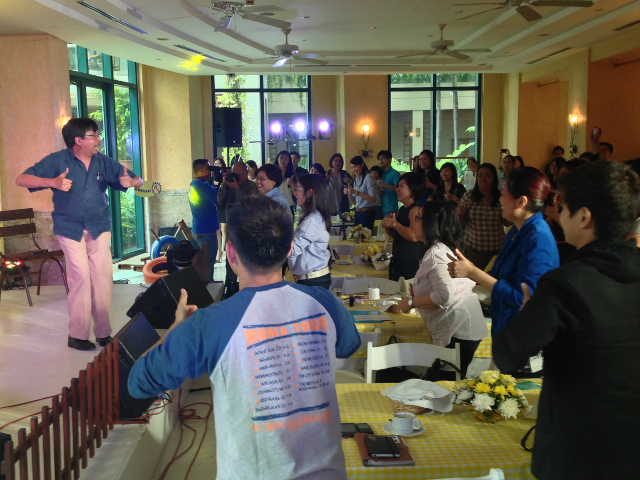The meaning of "playtime" among today's children might have already lost the sense of "togetherness" as a result of modern gaming gadgets that encourage the young ones to seek private time to play. I grew up in the '90s, when most children wanted to play outdoors with other kids in the neighborhood every time there was time to do so, and until their parents pulled them back home.

Media practitioners at the launching of DepEd's campaign to preserve the value of children's playtime. Amanda Fernandez
I remember my favorite game – "tinda-tindahan" – that I used to play with my older sister. We would gather all our toys and books together, put makeshift price tags on them and line them all up on the table that we set up in our backyard. We had play money, a calculator, a box we used as cash register, and scratch paper as receipts. We took turns in playing the role of the tindera (saleslady) and the shopper. Using our imagination, our tinda-tindahan seemed so real as we acted out the characters in our made-up world. But that was more than a decade ago. Nowadays, I see my young nephews cooped up inside the house with all their iPads, Nintendo Wii, Gameboys, laptops and other gaming gadgets that don't require the presence of a playmate. As gaming technology advances, traditional games such as taguan, luksong tinik, piko, and my tinda-tindahan are slowly being pushed toward the periphery of the Filipino children's consciousness, together with the natural craving to be with others to play. Some groups have exerted extra effort to preserve the social nature of children's play, especially among Filipinos. Last Wednesday, the Department of Education – together with the United Nations Children’s Fund, Play Pilipinas, and Johnson and Johnson Philippines – launched the campaign 'Di Lang Laro Ang Laro' at Palm Grove, Rockwell in Makati City. The campaign also emphasized the importance of one-hour daily active play in children's health and holistic development.
'Bring back playtime' During the launch, media people joined other guests in a workshop, playing games and dancing and generally having a fun time to be "silly" like kids. The workshop area was set up in bright colors and some playground items were scattered around the room, making me nostalgic about the good old days of my childhood. Kuya Bodjie, best known for hosting a kiddie infotainment show in the '90s, led the first part of "silly dancing."

Kuya Bodjie takes the lead in 'silly dancing.' Amanda Fernandez
He asked everyone in the room to wave their arms, stick out their tongues, and jump around like silly kids. The second part of the workshop was led by TV host May Soriano. She made everyone play games like Doctor Quackquack, rock paper scissors, and other loud games. "Walang lunch ang mga talo," she joked, making all the participants compete as if their meals depended on how well they played. According to Sigrid Perez, executive director of Play Pilipinas and mother of eight children, some of their workshops are set up for parents to make them realize their need to understand the importance of playtime for kids. "Play is a biological need. It is a natural desire, a need for children, just like eating, drinking," she said. Trina Almario-Tanlapco, group brand manager of Johnson and Johnson Philippines, noted how some parents nowadays even discourage their children from playing. "Tingin nila distraction ang playing," she said. "Moms mismo ang nagdi-discourage sa mga anak na maglaro." According to Atty. Tonisito Umali, the Department of Education's legal affairs assistant secretary, children learn a lot of life lessons and values from playing. "Iyan po ang nakikita natin sa tuwing naglalaro ang ating mga anak: focus, team work, kooperasyon ng ating mga anak sa kanyang mga kalaro, pakikisama, pakikisalamuha, kakayahang tumayo matapos madapa," he said. "Iyan po ang kailangan ding matutunan ng ating mga anak," he added. Meanwhile, Lulay De Vera-Mateo, Chief of Education at UNICEF, said playtime helps kids become less timid and confident.
— LBG/KG, GMA News 





